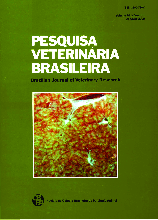 |
|
|
|
Year 2000 - Volume 20, Number 1
|

|
Immunohistochemical detection of Tritrichomonas foetus in experimentally infected mice, 20(1):43-46
|
ABSTRACT.- Monteavaro, C.E., Soto P., Echevarría H.M., Catena M.C., Portiansky E.L. & Gimeno E.J. 2000. Immunohistochemical detection of Tritrichomonas foetus in experimentally infected mice. [Detecção imunohistoquímica de Tritrichomonas foetus em camundongos experimentalmente infectados.] Pesquisa Veterinária Brasileira 20(1):43-46. Institute of Pathology, Veterinary School, UNLP, P.O.Box 296, 1900 La Plata, Argentina.
The need to intensify knowledge of the pathogenesis of bovine genital trichomoniasis (BGT) led to the use ofalternative animal models such as the mouse. Nevertheless, it is necessary to elucidate the dynamics of the infection in this animal species, evaluating different stages of the colonization and evolution of the pathological alterations. The immunohistochemistry (IHC) of fers advantages over the routine histopathological staining techniques for the detection of the protozoan in tissues, cellular detritus and inside the macrophages. The goal of the present study was to demonstrate the presence of Tritrichomonas foetus in the reproductive tract of infected mice using an IHC technique. Female BALB/c mice were infected with a suspension of T. foetus by intravaginal route, in the estrum phase, detected by exfoliative vaginal cytology. After 10 weeks, the animais were sacrificed; uterus and vagina were fixed and histologically processed. Some slides were stained with HE. The rest of the slides were processed for IHC. An immunoadsorbed polyclonal serum against T. foetus was used. The. avidine-biotine technique (HistoMouse, Zymed ™) was employed. The histopathological studies showed a dilation of the uterine glands, presence of macrophages in the lumen of the organ and inner part of the endometrial glands. No T. foetus was identified tísing this method. The IHQ allowed additionally the identification of the protozoan in the endometrium, endometrial glands, uterine lumen and inside neutrophils and macrophages. The cytological studies stained with IHC showed either isolated T. foetus adhered to epithelial cells or inside macrophages. This technique proves to be a useful tool for the study of the pathogenesis of bovine genital trichomoniasis (BGT) in an experimental model. |
| |
|
|
| |
|
 |